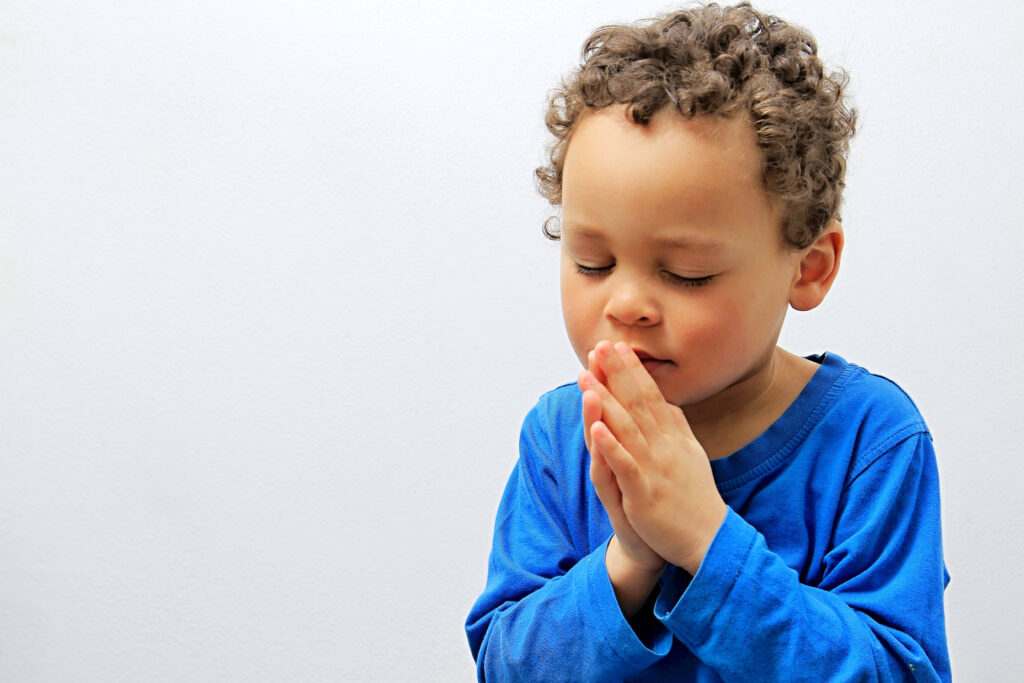
Why And How We Teach Our Children To Pray—
My 15-month-old son Ezra has recently been throwing his hands up to motion “touchdown!” Neither his father nor I sat down and taught him to do this, but it makes sense. It is fall, football season is here, and the Burton family watches a lot of football. Ezra has watched us and watched friends that have come over cheer and celebrate, signaling our team has scored. In watching us, he’s learned to do the same.
This is how our children learn a lot of things! They are always listening and they’re always observing and learning all kinds of things. I have been thinking a lot about other things that Ezra may be learning from us. I think about what I want the children in our church to learn from the people they engage with—me, Sunday School teachers, pastors, etc. One thing I want them to learn is what prayer is, who we are praying to, and how we pray.
The New City Catechism, question 38 is “What is Prayer?” “Prayer is pouring out our hearts to God in praise, petition, confession of sin, and thanksgiving.”
Prayer is the Christian’s lifeline. It really is the rhythm of the Christian life. Because God is who He says He is, we’re able to approach His throne confidently. We offer our praise to Him, Elohim, the God who created all things, who clothed the flower in color and gave the bird its song. We’re able to offer our petition, to cry out for help, knowing that He is faithful and trustworthy. Because God is true to His word, we’re able to confess our sin and our need for a Savior. Then, in response to all that He has done, we’re able to fall on our knees in gratitude.
We’re not told that prayer is the rhythm of the Christian life and then left to figure out how to do that alone. If the Lord’s Prayer tells us in a nutshell what we should pray, it is the Psalms that tell us how we should pray. In the Psalms we see the whole spectrum of human emotion and experience. Praying the Psalms is a beautiful way to bolster our personal prayer lives, but it is also a wonderful place to take our children when teaching them to pray. One psalmist uses the sensory language of “taste and see that the Lord is good.” Jonathan Edwards in commenting on Psalm 34 noted the psalmist used this language because it’s one thing to know God is good and holy, but it is another to sense His goodness and holiness in your heart in prayer.
This really should serve as a reminder of the gift it is to experience the faithfulness of God and communion with Him in prayer. A great start to helping our children learn to pray is modeling for them a life marked by prayer.
It is very easy for our children to pick up a view of prayer where God is like Santa or a fairy, only being approached when we want or need something. While we definitely should come to God with our needs, prayer is more than that. It’s important to help our children understand to whom they are praying. The God to whom they pray is loving (1 John 4:8); He is faithful (1 Cor. 10:13); He is patient (2 Peter 3:9); He is gracious (Ps. 116:5), and so much more. Once our children have an understanding of whom they are praying to, it will shape how they’re praying.
I think one of the best ways to reinforce how important prayer is in the daily rhythm of life is to have children in the worship service on Sundays. Every week, we are shown the rhythm of how life works best, how we are to live. Prayer is an essential part of our service on Sunday. We can point to that as a way to reinforce the importance of prayer in our lives.
Nancy Guthrie’s What Every Child Should Know About Prayer is an invaluable resource that can be read with children. I cannot recommend it enough. One of the most helpful resources for my prayer life personally has been Tony Souder’s Pray for Me Prayer Guide. For seven years I have been praying Scripture over students in my church. The Lord has used those prayers to encourage me immensely over the years.
Just as Ezra has picked up “touchdown,” I pray he and the children in our church will learn how to pray and to love the One to whom we pray from watching, our Sunday School volunteers, their parents, and pastors, and me live lives marked by prayer and dependence on the One who answers prayer.

Mary Elizabeth Burton grew up in Alabama and graduated from Auburn University. After graduating, she worked for RUF at TCU before moving to Chattanooga in 2016. In April, Mary Elizabeth took over the Children’s Ministry at her church, North Shore Fellowship. Before that she served on staff with the ministry of One Hundred Years. Her days are filled with chaos and adventure provided by her son, Ezra and golden retriever, Hanks. Mary Elizabeth and her husband, Davis, are lovers of sports, being outside, good books and tacos.
